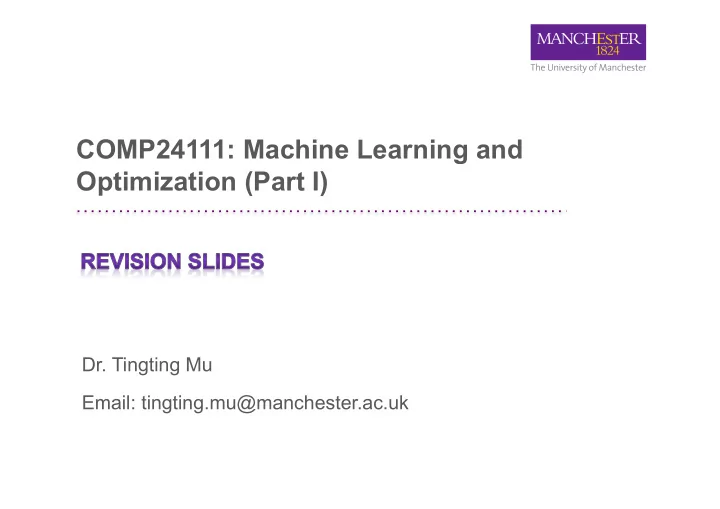

COMP24111: Machine Learning and Optimization (Part I) Dr. Tingting Mu Email: tingting.mu@manchester.ac.uk
Exam Information • Exam on week 1-5 content includes: – 15 MCQ questions (one mark each question). – 15 marks of written questions. • Revision material: – Lecture notes (Comp24111 website). – Podcast (Blackboard). – Comments in annotated lecture notes (Blackboard). – Exercises and MCQ practices with solution (Comp24111 website). – Mock exam paper with solution (Comp24111 website). – Past exam papers (for taught parts). 1
Examination Content and Methods: Chapter 1 Content Assessing Method Basic ideas of machine learning. MCQ Typical learning types (unsupervised, supervised, MCQ reinforcement learning). k-NN classifier: • K-NN classification rules (core idea and pseudo code). • k-NN behaviour vs. neighbour number and training MCQ, written sample size. questions • Usage of k-NN (e.g., suitable for both linear and nonlinear classification). Basic machine learning experiment settings (training, MCQ testing, classification accuracy and error rate ) 2
Examination Content and Methods: Chapter 2 Assessing Content Method Definition of classification and regression tasks. MCQ Basic machine learning ingredients (model, error function, learning). MCQ Linear model based on least squares solution: • Model formulation and model parameter, sum-of-squares error. MCQ and • Derive the best setting of the model parameter for cases with one written input variable and one output variable (e.g., MAIP example). questions • Usage of linear model for regression and classification. • Basic idea of regularised least squares model. Basic ideas of gradient descent, stochastic gradient descent, and MCQ mini-batch gradient descent. 3
Examination Content and Methods: Chapter 3 Content Assessing Method Definition of likelihood and maximum likelihood estimator. MCQ Logistic regression model: • Basic idea of the model. • Training by likelihood maximisation (equivalent to loglikihood mamixisation and cross-entropy error MCQ minimisation, IRLS update is not required in exam). • Usage of logistic regression (e.g., suitable for linear, two-class and multi-class classification). Linear basis function models. • Basic idea. • Be able to compute the new features given the original MCQ and written features and the basis functions. questions • Usage of the model (e.g., suitable for nonlinear classification). 4
Examination Content and Methods: Chapter 4 Assessing Content Method Support vector machines: • Basic idea of SVM (separation margin, support vectors, slack variables, and hinge loss). MCQ • Linear/nonlinear, separable/non-separable data patterns. • Usage of different types of SVM (hard-margin, soft-margin, linear and kernel SVM). Kernel trick. • Basic idea. MCQ and written • Be able to compute the inner product between two data points given questions their original features and the kernel function. Data split schemes used in machine learning experiments, and their MCQ usage in hyperparameter selection. Different classification performance measures (confusion matrix, MCQ and written specificity, sensitivity, precision, recall, F 1 score). questions. 5
Examination Content and Methods: Chapter 5 Assessing Content Method Single neuron model (adder and activation). MCQ Perceptron algorithm: • Rules for updating (training) model parameters. MCQ • Usage of the algorithm (linear, two-class classification). Multilayer perceptron (feedforward artificial neural network): • Architecture (input, hidden and output layers) • Be able to compute the number of neural network parameters to be trained, given layer number and the neuron number in each layer. MCQ • Basic idea of backpropagation. • Usage of the method (e.g., suitable for processing nonlinear data patterns, regression, two-class and multi-class classification). Deep learning (many hidden layers). MCQ 6
Recommend
More recommend